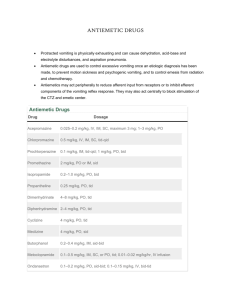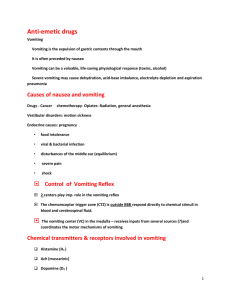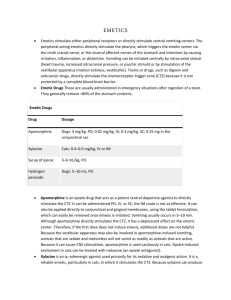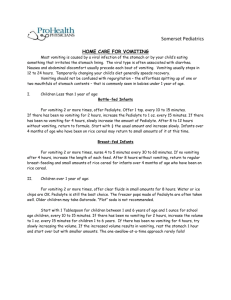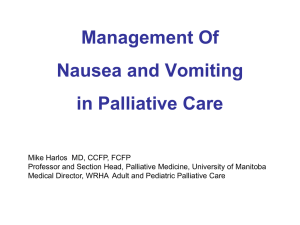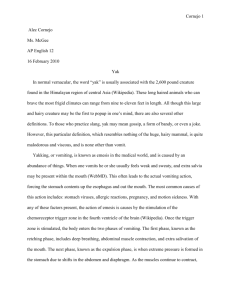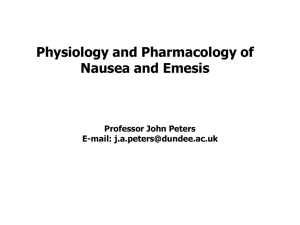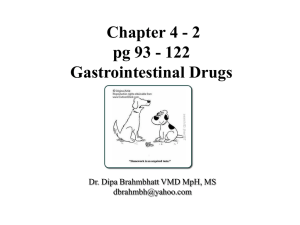Treatment and Control of Vomiting
advertisement
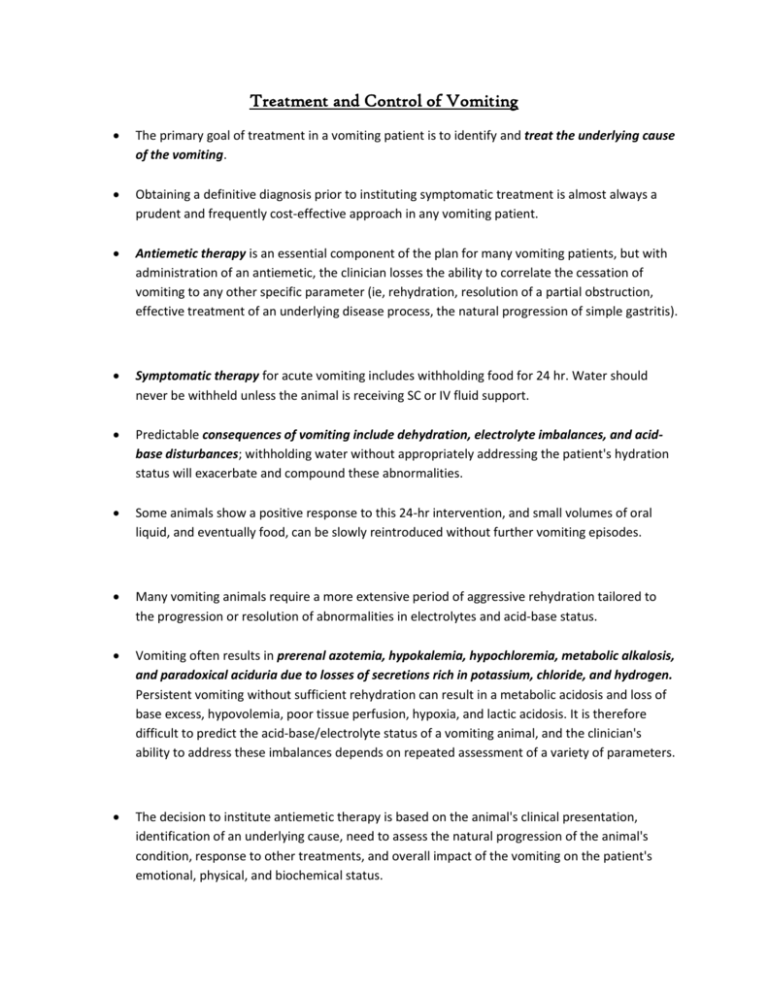
Treatment and Control of Vomiting The primary goal of treatment in a vomiting patient is to identify and treat the underlying cause of the vomiting. Obtaining a definitive diagnosis prior to instituting symptomatic treatment is almost always a prudent and frequently cost-effective approach in any vomiting patient. Antiemetic therapy is an essential component of the plan for many vomiting patients, but with administration of an antiemetic, the clinician losses the ability to correlate the cessation of vomiting to any other specific parameter (ie, rehydration, resolution of a partial obstruction, effective treatment of an underlying disease process, the natural progression of simple gastritis). Symptomatic therapy for acute vomiting includes withholding food for 24 hr. Water should never be withheld unless the animal is receiving SC or IV fluid support. Predictable consequences of vomiting include dehydration, electrolyte imbalances, and acidbase disturbances; withholding water without appropriately addressing the patient's hydration status will exacerbate and compound these abnormalities. Some animals show a positive response to this 24-hr intervention, and small volumes of oral liquid, and eventually food, can be slowly reintroduced without further vomiting episodes. Many vomiting animals require a more extensive period of aggressive rehydration tailored to the progression or resolution of abnormalities in electrolytes and acid-base status. Vomiting often results in prerenal azotemia, hypokalemia, hypochloremia, metabolic alkalosis, and paradoxical aciduria due to losses of secretions rich in potassium, chloride, and hydrogen. Persistent vomiting without sufficient rehydration can result in a metabolic acidosis and loss of base excess, hypovolemia, poor tissue perfusion, hypoxia, and lactic acidosis. It is therefore difficult to predict the acid-base/electrolyte status of a vomiting animal, and the clinician's ability to address these imbalances depends on repeated assessment of a variety of parameters. The decision to institute antiemetic therapy is based on the animal's clinical presentation, identification of an underlying cause, need to assess the natural progression of the animal's condition, response to other treatments, and overall impact of the vomiting on the patient's emotional, physical, and biochemical status. Many antiemetics are available, and their effectiveness is often a function of which and/or how many of the previously described inputs to the vomiting center they target. Antiemetics that are particularly efficacious in animals with vestibular disease may be of little help to animals whose vomiting is secondary to renal failure, for example. Drugs that act directly on the vomiting center include the phenothiazine tranquilizers such as prochlorperazine and chlorpromazine. Phenothiazine agents also inhibit activity of the CRTZ and have weak anticholinergic effects, making them a particularly powerful and effective choice in many animals. Although the antiemetic effects are seen at dosages lower than those required for tranquilization, hypotension is a potential adverse effect. Thus, it is essential that animals are adequately rehydrated prior to instituting phenothiazine therapy. A new class of antiemetic that appears to work at both the vomiting center and the CRTZ is the NK-1 receptor antagonist maropitant. Maropitant was first introduced as a prophylactic for animals with cancer undergoing chemotherapy. Its use has been extended to effectively stop acute vomiting secondary to a wide variety of causes and for the treatment of motion sickness. The administration of maropitant includes a “washout” period (5 days on/2 days off for vomiting; 2 days on/3 days off for motion sickness). Mild, transient discomfort following SC injection may occur in some animals. The dose for cats has not yet been established but seems to be approximately one-half of the dose for dogs. Drugs used primarily for motion sickness and/or vestibular disease include meclizine and diphenhydramine. These antihistamines work by blocking H1 receptors in the vestibular apparatus and, to a lesser extent, the CRTZ. The antimuscarinic agent, , is also used for motion sickness. Drowsiness and xerostomia are potential adverse effects of these drugs. Dopaminergic antagonists such as metoclopramide act at the level of the CRTZ and peripheral receptors and are considered useful in the management of vomiting secondary to a variety of causes. The efficacy of metoclopramide as an antiemetic in cats is under review, as cats may not have dopaminergic receptors in their vomiting centers. Ondansetron is a potent antiemetic agent that acts as a selective 5-HT3 serotonin-receptor antagonist with both central and peripheral activity. The peripheral release of serotonin has been shown to play an important role in the vomiting response to chemotherapeutic administration, and ondansetron should be considered in cancer patients prior to therapy as well as other cases unresponsive to other antiemetic agents. Similar to ondan-setron, is a serotonin 5-HT3 antagonist used to reduce nausea and vomiting secondary to anesthesia, chemotherapy, enteritis, and renal and hepatic disease. In addition to pharmacologic manipulation designed to prevent GI contents from being expelled in a retrograde direction, a vomiting patient may also respond to pharmacologic intervention aimed at moving ingesta in the appropriate direction. Although any possibility of an obstruction or foreign body is a contraindication, promotility drugs such as metoclopramide, ranitidine, lowdose erythromycin and cisapride should be considered in the therapeutic plan.
